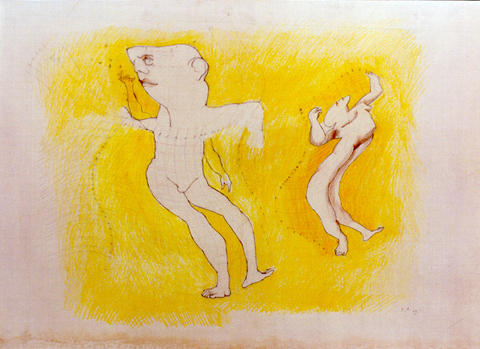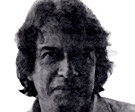
Enrique Castro-Cid (1937-1992)
“YELLOW CONTORTION”
Signed “C.C. '69” lower right,
pencil on paper 30 x 44 inches.
$5,500 USD
boyce@karlie.com
 "Space as an act of reflection is absolute, yet, as a phenomenon presents many forms and gradations. Euclidean geometry represents space as an absolute category, this is, as an entity independent of our experience. At the beginning of this century, relativity shattered the epistemological foundation of the Newtonian-Euclidean world picture when it denied the notion of absolute space and time in the physical world. The use of non-Euclidean geometries in my work responded initially to this epistemological rupture. Certainly one of the most beautiful disciplines in mathematics has been used to further this pictorial argument, that of conformal mapping. Conformal transformations have been used to interpret the behavior of electrical currents and also to depict the configuration of electromagnetic potentials. The intrinsic geometry of the rectangular canvas is Euclidean, that is it represents space as an absolute. By contrast my work examines the possibility of alternative space models for painting in which the notion of absolute space has been transgressed”.
"Space as an act of reflection is absolute, yet, as a phenomenon presents many forms and gradations. Euclidean geometry represents space as an absolute category, this is, as an entity independent of our experience. At the beginning of this century, relativity shattered the epistemological foundation of the Newtonian-Euclidean world picture when it denied the notion of absolute space and time in the physical world. The use of non-Euclidean geometries in my work responded initially to this epistemological rupture. Certainly one of the most beautiful disciplines in mathematics has been used to further this pictorial argument, that of conformal mapping. Conformal transformations have been used to interpret the behavior of electrical currents and also to depict the configuration of electromagnetic potentials. The intrinsic geometry of the rectangular canvas is Euclidean, that is it represents space as an absolute. By contrast my work examines the possibility of alternative space models for painting in which the notion of absolute space has been transgressed”.
-Enrique Castro-Cid
Biography:
Enrique Castro-Cid, a Chilean artist interested in space, shape, texture, and movement and fascinated with modern technology, was born in 1937. He studied in Chile and then in 1961, he arrived in New York City, where, in 1962 the Organization of American States bestowed upon him a grant to study in the United States, citing his potential and creativity.
In the United States, Castro-Cid was awarded two Guggenheim Foundation Fellowships in 1964 and again in 1965 and won the William Copley award in 1966. Kinetic sculptures and robots were his first creations and he designed the robot hound in Francois Truffaut’s 1966 film, Fahrenheit 451. Eventually, he outgrew his earlier interests and turned to painting. Under this aegis, he married art and science. He minutely explored the shapes and movements of living things and began creating a perspective that ignored the norms of geometry and focused on form.
He received support from the Guggenheim Museum, the Museum of Modern Art, and the Brooklyn Museum as well as exhibited at the Richard Feign and Droll/Kolbert Galleries in New York. He later served as a Fellowship juror for the Guggenheim Foundation and the University of Illinois appointed Castro-Cid "visiting artist" in 1968. It was in that collegiate environment that he melded mathematics and art and produced innovative and individualistic work that embodied his artistic philosophy and personal beliefs.
Later, he relocated to Miami, Florida where he reveled in that environment’s casual lifestyle. Here he spent hours with the computers in various venues exploring spatial concepts for his paintings and drawings. He was a true artist who looked beyond the obvious and painted only that which could be seen by the artist. These introspections he presented to the viewer through a wide range of mediums – oils, pen and ink, acrylics, and watercolors.
Castro-Cid was married Christophe de Menil of the de Menil family of art patrons and among his friends were Willem de Koonig, James Rosenquist, William Copley and George Plimpton.
While visiting Santiago, Chile in 1992, Castro-Cid died of a heart attack.
